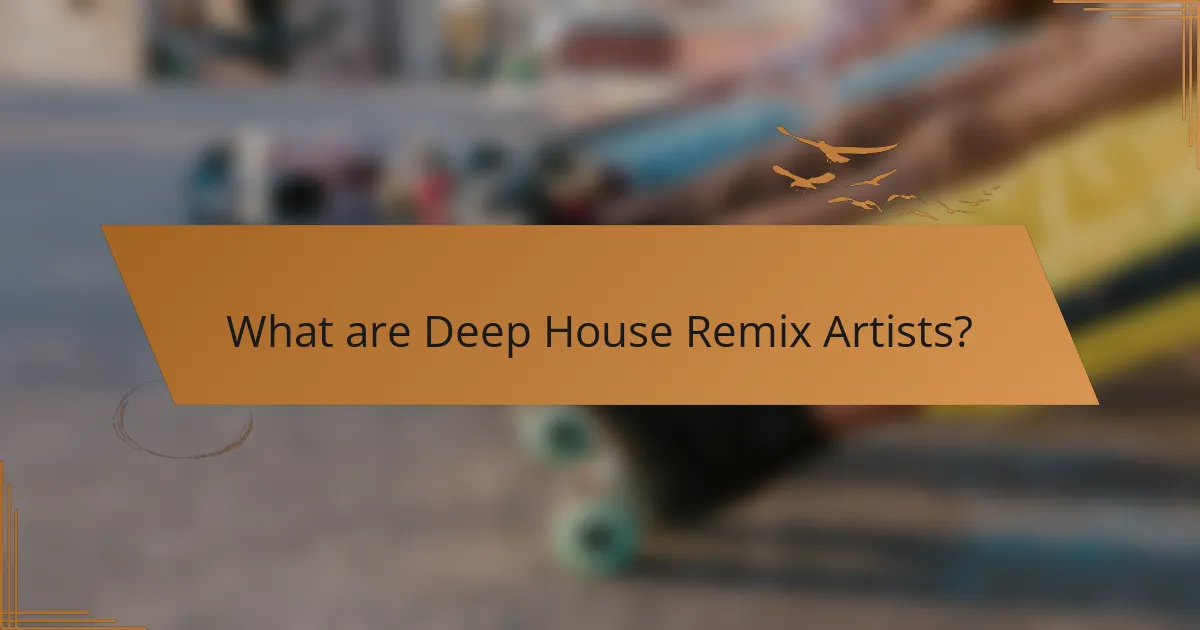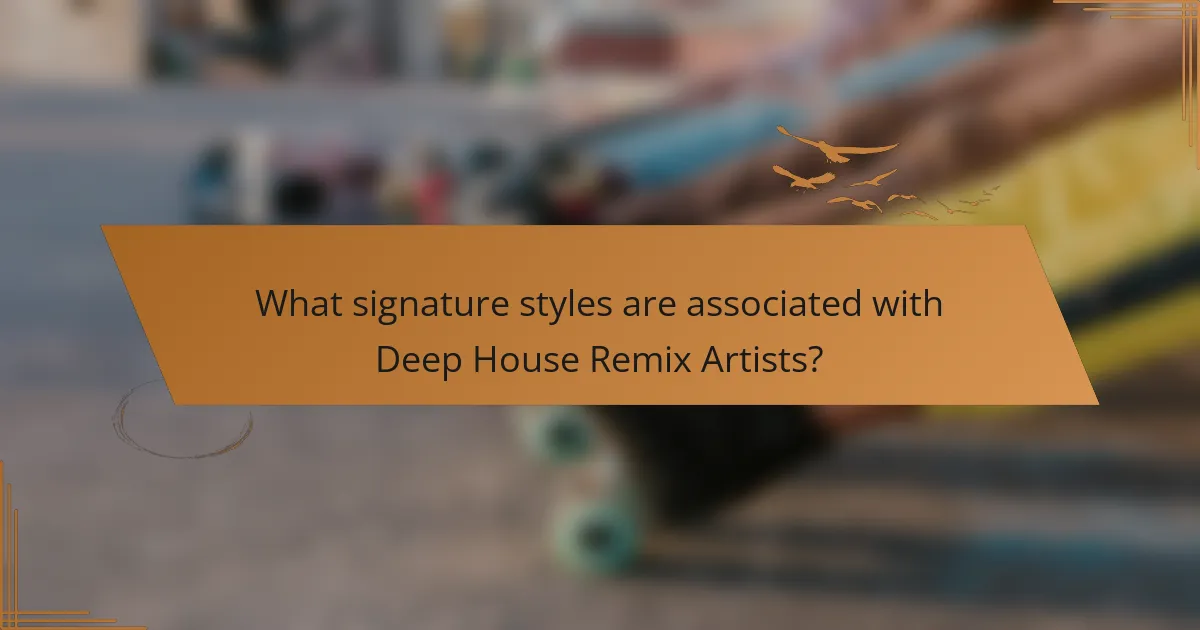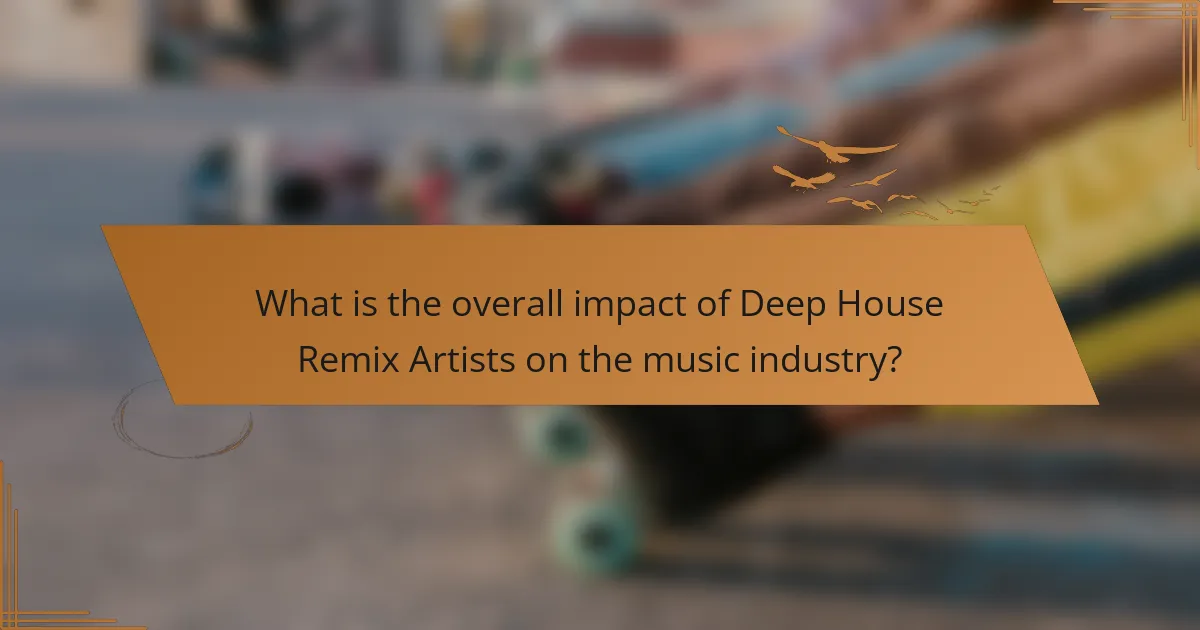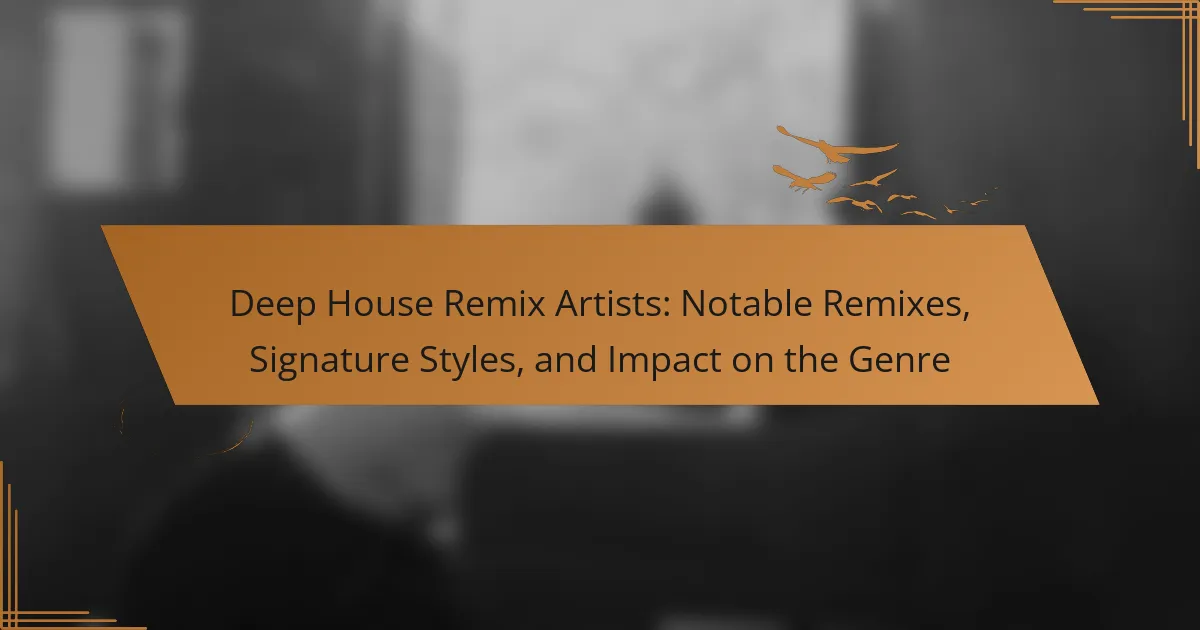Deep House Remix Artists are musicians specializing in creating remixes of deep house music tracks, characterized by smooth melodies, deep basslines, and soulful vocals. This article explores notable artists in the genre, such as Frankie Knuckles and Kerri Chandler, and highlights their innovative production techniques that enhance the emotional depth of remixed tracks while maintaining danceability. The impact of these artists on the music industry is significant, as they blend various genres and revitalize older songs, expanding the reach of deep house music. Additionally, the rise of streaming platforms has amplified their visibility, showcasing their role in shaping contemporary soundscapes and modern music trends.

What are Deep House Remix Artists?
Deep House Remix Artists are musicians who create remixes of deep house music tracks. They often reinterpret existing songs by adding new elements or altering the original composition. These artists typically focus on creating a smooth, soulful sound that is characteristic of deep house. Notable names in this genre include artists like Frankie Knuckles and Kerri Chandler. Their remixes can enhance the emotional depth of a track while maintaining danceability. The impact of these artists on the genre is significant, as they help popularize deep house music in various music scenes. Their work often showcases innovative production techniques and unique stylistic choices that define the deep house sound.
How do Deep House Remix Artists influence the genre?
Deep House Remix Artists significantly influence the genre by introducing new sounds and techniques. They reinterpret existing tracks, adding unique elements that reshape the original compositions. This process often involves altering beats, harmonies, and melodies to create fresh interpretations. Their remixes can elevate lesser-known tracks, bringing them to wider audiences. The blending of various musical styles within remixes also expands the genre’s appeal. Notable artists like MK and Duke Dumont have successfully transformed tracks, showcasing their signature styles. Their work often results in chart-topping hits, demonstrating commercial viability. This impact encourages further innovation and experimentation within the deep house genre.
What characteristics define a Deep House Remix Artist?
A Deep House Remix Artist is defined by their ability to blend soulful melodies with rhythmic beats. They typically incorporate elements from various genres, including jazz and funk. Their remixes often feature smooth basslines and atmospheric synths. A Deep House Remix Artist usually emphasizes vocal samples in their tracks. They often create a laid-back, yet danceable vibe. Mastery of production techniques is a common characteristic among these artists. Many have a distinct signature style that sets them apart. Their work significantly influences the evolution of the deep house genre.
How do these artists differentiate themselves from other genres?
Deep house remix artists differentiate themselves through unique soundscapes and production techniques. They often blend elements from various genres, such as jazz, soul, and funk. This fusion creates a distinctively smooth and melodic vibe. Additionally, their use of atmospheric pads and deep basslines sets them apart from other electronic music styles. Many deep house artists prioritize emotional and immersive experiences in their tracks. This focus on mood contrasts with the more upbeat tempos found in genres like techno or house. Furthermore, vocal sampling and intricate arrangements are common in their work, enhancing their signature sound. The result is a subgenre that emphasizes groove and subtlety, appealing to a specific audience.
What notable remixes have shaped the Deep House genre?
Notable remixes that have shaped the Deep House genre include the remix of “Can’t Get Enough” by Soulsearcher. This remix became a classic, characterized by its smooth bassline and soulful vocals. Another significant remix is “I Feel for You” by Bob Sinclar, which infused disco elements into Deep House. The remix of “Finally” by Kings of Tomorrow also played a crucial role, showcasing emotive lyrics and a deep groove. Additionally, the “Deep Inside” remix by Hardrive highlighted the genre’s roots in garage and funk. These remixes collectively influenced the sound and direction of Deep House music, establishing key characteristics that define the genre today.
Which remixes are considered iconic in Deep House?
Iconic remixes in Deep House include “Can’t Get Enough” by Soulsearcher, remixed by various artists. Another significant remix is “Finally” by Kings of Tomorrow, particularly the remix by DJ Pierre. “Deep End” by John Summit has also gained iconic status with its popular remixes. Additionally, “The Cure and The Cause” by Fish Go Deep is often highlighted for its impactful remixes. These tracks are celebrated for their influence on the genre and have been pivotal in shaping Deep House music.
How have these remixes impacted the evolution of the genre?
Remixes have significantly influenced the evolution of deep house music. They have introduced new sounds and techniques, expanding the genre’s boundaries. Artists often blend elements from other genres, creating innovative tracks. This cross-pollination has led to a richer sonic palette. Notable remixes have also revitalized older tracks, bringing them to new audiences. For example, remixes of classic deep house songs have gained popularity on streaming platforms. As a result, the genre has seen increased mainstream recognition. The evolution of deep house is closely tied to the creativity found in these remixes. Overall, remixes serve as a catalyst for growth and transformation within the genre.

What signature styles are associated with Deep House Remix Artists?
Deep House Remix Artists are known for their signature styles that blend smooth melodies with deep basslines. They often incorporate soulful vocals and jazzy chords. Many artists utilize atmospheric pads to create an immersive sound. Their remixes frequently feature laid-back tempos, typically around 120 to 125 BPM. Artists also emphasize groove through rhythmic percussion and intricate drum patterns. Additionally, they may integrate elements from other genres, such as funk or disco. This fusion contributes to the unique sound of deep house. The signature styles of these artists have significantly shaped the genre’s evolution.
How do signature styles vary among different artists?
Signature styles among different artists vary significantly based on their musical influences and production techniques. Each artist brings a unique sound that reflects their personal experiences and creativity. For instance, some artists may focus on melodic elements, while others emphasize rhythm and basslines. The choice of samples and synthesizers also contributes to their distinctiveness. Additionally, artists might incorporate various genres, such as jazz or funk, into their deep house remixes, creating a hybrid style. This variation allows listeners to identify and appreciate the individuality of each artist’s work. The diversity in signature styles enriches the deep house genre, making it more dynamic and appealing to a broader audience.
What elements contribute to a signature style in Deep House?
A signature style in Deep House is characterized by specific musical elements. These elements include smooth basslines that provide a warm foundation. Melodic synths often create a dreamy atmosphere. Vocal samples contribute emotional depth and human connection. Rhythmic patterns typically feature a four-on-the-floor beat. Chord progressions are usually jazzy or soulful, enhancing the genre’s vibe. Production techniques often involve reverb and delay for spatial effects. The overall tempo generally ranges between 120 to 125 BPM, maintaining a laid-back groove. These components collectively shape the distinct sound of Deep House.
Which artists are known for their unique sound within the genre?
Artists known for their unique sound within the deep house genre include Four Tet, Disclosure, and Jamie Jones. Four Tet blends elements of electronic music with organic sounds, creating a distinctive style. Disclosure is recognized for their catchy hooks and polished production techniques. Jamie Jones incorporates a blend of techno and house, emphasizing groove and rhythm. Each artist has made significant contributions to the evolution of deep house, influencing the genre’s direction. Their remixes and original tracks showcase their individual sounds, setting them apart in the music industry.
What techniques do Deep House Remix Artists commonly use?
Deep House Remix Artists commonly use techniques such as sampling, layering, and modulation. Sampling involves taking snippets of existing tracks and incorporating them into new compositions. Layering adds depth by combining multiple sounds or instruments to create a rich audio texture. Modulation alters sound parameters over time, enhancing dynamics and interest.
Additionally, artists often employ effects like reverb and delay to create space and atmosphere in their remixes. Beat manipulation is frequently used to adjust tempo and rhythm, aligning with the deep house groove. These techniques are essential for producing distinctive and engaging remixes that resonate within the genre.
How do production techniques affect the final remix?
Production techniques significantly shape the final remix. Techniques such as layering, equalization, and effects processing determine the sound quality. Layering adds depth and richness to the track. Equalization balances frequencies, enhancing clarity and presence. Effects processing, including reverb and delay, creates atmosphere and space. The choice of samples influences the overall vibe and style. Additionally, the mixing process ensures all elements blend cohesively. Each technique contributes to the uniqueness of the remix, impacting listener perception and emotional response.
What role does sampling play in Deep House remixes?
Sampling is a fundamental element in Deep House remixes. It allows artists to incorporate existing tracks or sounds into new compositions. This practice enhances creativity and provides a unique auditory experience. Sampling can introduce nostalgic elements through recognizable melodies or hooks. It also enables the blending of different musical genres, enriching the Deep House sound. Moreover, it contributes to the genre’s evolution by encouraging innovation. Notable Deep House artists often utilize sampling to pay homage to classic tracks. The use of samples can also impact the emotional depth of a remix, engaging listeners in a familiar yet fresh way.

What is the overall impact of Deep House Remix Artists on the music industry?
Deep House Remix Artists significantly influence the music industry by shaping contemporary soundscapes. They blend various genres, creating innovative tracks that attract diverse audiences. This fusion expands the reach of deep house music beyond traditional club settings. Their remixes often revitalize older songs, introducing them to new listeners. For example, artists like MK and Duke Dumont have successfully remixed tracks that topped charts. The rise of streaming platforms has further amplified their impact. Data shows that remixes often garner millions of plays, enhancing artist visibility. Overall, Deep House Remix Artists play a crucial role in the evolution of modern music trends.
How have these artists contributed to the popularity of Deep House music?
These artists have significantly contributed to the popularity of Deep House music through innovative remixes and distinct styles. Their unique sounds often blend elements of jazz, funk, and soul, attracting diverse audiences. Notable remixes have revitalized classic tracks, introducing them to new listeners. Collaborations with mainstream artists have further elevated the genre’s visibility. Festivals and club events featuring these artists have created vibrant communities around Deep House. Their consistent output on streaming platforms has also increased accessibility. Additionally, social media promotion has helped in reaching wider audiences. Overall, their creative contributions have played a crucial role in Deep House’s growth and mainstream acceptance.
What trends have emerged as a result of their remixes?
Emerging trends from deep house remixes include a fusion of genres and increased collaboration among artists. These remixes often blend elements from pop, techno, and R&B, creating unique soundscapes. Additionally, the rise of online platforms has facilitated wider distribution and accessibility of remixes. This has led to a more diverse audience engaging with deep house music. The popularity of remixes has also influenced the production techniques used in the genre. Artists are now experimenting with layered sounds and innovative beats. Furthermore, social media has become a powerful tool for promoting remixes and connecting with fans. This trend has resulted in a more interactive music experience.
How do Deep House Remix Artists collaborate with other genres?
Deep House Remix Artists collaborate with other genres by infusing elements from various musical styles into their tracks. They often incorporate vocals or instrumentation from genres like pop, hip-hop, or jazz. This blending creates a unique sound that appeals to a broader audience. For example, artists may sample hooks from popular songs and rework them into deep house beats. Collaborations can also occur through joint projects with artists from different genres. These partnerships often result in innovative remixes that push genre boundaries. The use of technology allows for seamless integration of diverse sounds. This cross-genre collaboration enhances the richness of deep house music.
What are the future prospects for Deep House Remix Artists?
The future prospects for Deep House Remix Artists appear promising. The genre continues to evolve, attracting a diverse audience. Streaming platforms are increasingly favoring remixes, enhancing visibility for artists. Collaborations with mainstream musicians are becoming more common, expanding reach. Additionally, the rise of social media allows for direct engagement with fans. Emerging technologies, such as AI, are providing new tools for creativity. The global electronic music scene is also growing, creating more opportunities. Overall, Deep House Remix Artists are well-positioned for continued success in the music industry.
How can emerging artists find success in the Deep House scene?
Emerging artists can find success in the Deep House scene by focusing on building a unique sound. Developing a signature style sets them apart from others. Networking with established artists can provide valuable opportunities for collaboration. Utilizing social media platforms helps in reaching a wider audience. Regularly releasing quality tracks keeps listeners engaged. Performing at local venues increases visibility within the community. Engaging with fans through live streams and Q&A sessions fosters loyalty. Participating in music contests can also gain recognition and exposure.
What challenges do Deep House Remix Artists face in the current music landscape?
Deep House Remix Artists face significant challenges in the current music landscape. One major challenge is the oversaturation of the market. There are countless artists producing similar sounds, making it difficult to stand out. Additionally, the rise of streaming platforms has changed how music is consumed. Artists often receive lower revenue from streams compared to traditional album sales.
Another challenge is the need for constant innovation. Audiences expect fresh sounds and unique interpretations, which can pressure artists to continuously evolve. Collaborating with other artists can also be difficult due to differing creative visions. Furthermore, navigating copyright laws can be complex, especially when remixing existing tracks.
Finally, building a loyal fanbase in a crowded industry requires effective marketing strategies. Artists must leverage social media and digital marketing to reach potential listeners. These challenges collectively impact the ability of Deep House Remix Artists to succeed and thrive in today’s music environment.
What tips can aspiring Deep House Remix Artists follow?
Aspiring Deep House Remix Artists should focus on understanding the genre’s foundational elements. They need to study the structure of deep house tracks. This includes recognizing the importance of bass lines, melodic elements, and vocal samples. Experimentation with different sounds and styles is crucial. Artists should also familiarize themselves with popular DAWs like Ableton Live or FL Studio. Networking with other artists can provide valuable feedback and opportunities. Learning music theory can enhance their remixing skills. Finally, staying updated with current trends in deep house music is essential for relevance.
Deep House Remix Artists are musicians who specialize in reinterpreting deep house tracks, enhancing their emotional depth while maintaining danceability. This article explores their influence on the genre, notable remixes that have shaped deep house music, and the unique characteristics that define these artists. Key topics include signature styles, production techniques, and the impact of remixes on the evolution and popularity of deep house. Additionally, the article addresses challenges faced by artists in the current music landscape and offers tips for aspiring deep house remix artists seeking success.
